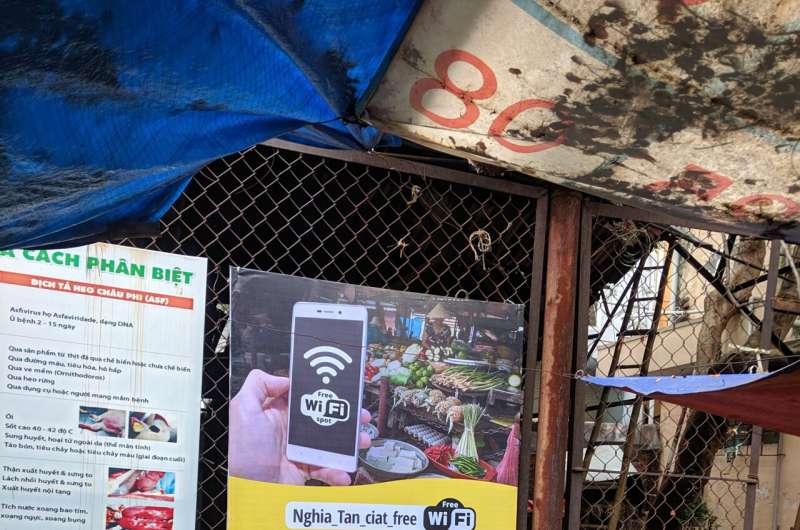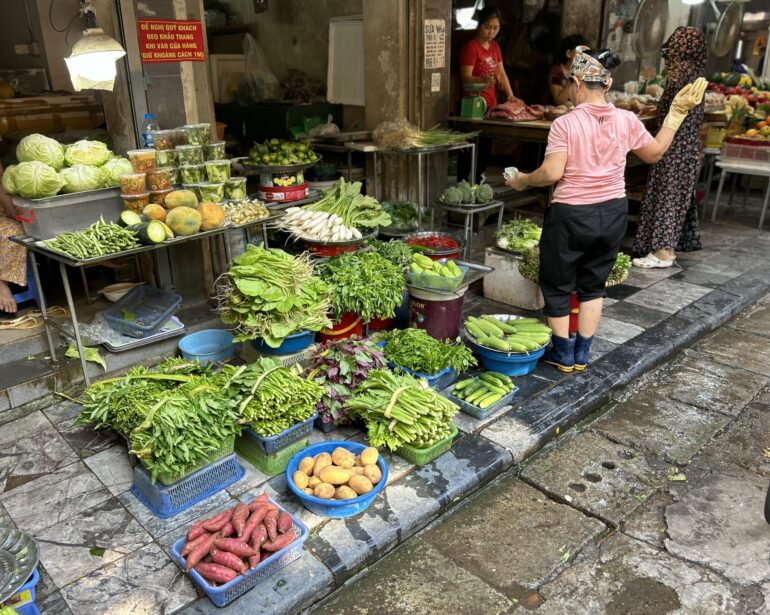by The Alliance of Bioversity International and the International Center for Tropical Agriculture
Researchers at the Alliance of Bioversity International and CIAT and their collaborators have been working on how to harness the power of the estimated 549 million Wi-Fi hotspots worldwide, resulting in a project that used anonymized data gathered from free Wi-Fi to better understand the impact of COVID-19 on Hanoi’s wet markets during the first stage of the COVID-19 pandemic.
In the paper “Using free Wi-Fi to assess impact of COVID-19 pandemic on traditional wet markets in Hanoi,” published in Food Security, the researchers analyzed and interpreted mobile device tracking data from 25 Wi-Fi access points to characterize the changes in behavior in the users of hundreds of stores and food stalls across five wet markets in Hanoi, from July 2019 to November 2020.
Lead author Louis Reymondin, who co-leads the Data Driven Sustainability research theme for the Alliance of Bioversity International and CIAT says that by counting the number of individual device addresses within a certain range of the access points, the researchers got a sense of the number of people present (with the details of users anonymized).
“We recorded every phone within the vicinity of the access points every 2 minutes, and recorded 173,668,702 data points, filtered down to 13,238,809 useful data points, corresponding to 656,789 unique devices observed, ” Reymondin says.
Reymondin explains that usually, if Wi-Fi is enabled on your smartphone, it is in “active-scanning” mode to detect available Wi-Fi hotspots, which in turn shares an address unique to every device with the hotspot
“This allows us to register all the devices present in the market, whether or not they are connected to the Wi-Fi network, and their movement in space and time,” Reymondin says. “The project’s novel feature was to install free Internet access through Wi-Fi in the markets to monitor changes in behaviors from markets’ actors.”
Reymondin’s group put their ideas into practice to complement more traditional survey approaches.
“We’ve been working with the Vietnamese government’s General Statistics Office (GSO) for years,” says Tuyen Huynh, scientist in Food Environment & Consumer Behavior at the Alliance of Bioversity International and CIAT and co-author of this study, “We’re known for food systems work under A4NH—Agriculture for Nutrition and Health research program in the country, so the government knows us, so it’s a good entry point to have the initial discussions.”

Researchers analyzed and interpreted mobile device tracking data from 25 Wi-Fi access points to characterize the changes in behavior in the users of hundreds of stores and food stalls across wet markets in Hanoi. © Louis Reymondin / Alliance of Bioversity and CIAT
Pandemic impact
Despite the rise of “modern” distribution channels (e.g., supermarkets, convenience stores), traditional wet markets continue to account for approximately 90% of total vegetable sales in Hanoi, serving as the primary source for daily nutrient intake, and contributing to 56% of energy intake. However, the absence of traceability and sales registration systems render the food flows within these markets largely invisible.
The researchers found during the initial phase of COVID-19 crisis, from February to July 2020, there was a significant decrease in both the total number and frequency of visits to the market, suggesting a reduction in consumers’ market engagement. Additionally, intermarket visits also experienced a sharp decline in these early months, suggesting a decrease in market operators’ activities. Furthermore, the peak time for market shopping shifted significantly, indicating substantial behavioral changes attributed to the COVID-19 crisis.
“Even after the city was reopened, with no limitations, the visits to the market were still lower and even though COVID was managed, the feeling that these markets are not as safe as a supermarket; this has led to a change,” Reymondin says, adding that the data suggests some intervention options for the future to counteract these trends.
Considering that the pandemic has disproportionately affected the poorest and most vulnerable populations nationwide, and recognizing the pivotal role of wet markets in providing access to fresh food and essential nutrients, the researchers advocate for reinforcing public health messaging related to nutrition and health.
Specifically, they propose emphasizing the significance of consuming fresh and nutritious food for health promotion during pandemics. This strategic messaging aims to underscore the crucial role such dietary habits play in sustaining robust immune systems and mitigating the risks of disease.
The researchers also proposed the enhancement of wet markets and associated infrastructure and facilities, aiming to facilitate the adoption of improved practices concerning hygiene and food safety conditions.
This upgrade is envisioned as a means to alter consumers’ negative perceptions of wet markets’ food safety—a perception likely exacerbated by the COVID crisis and society’s increasing desire for heightened sanitation.
Le Trung Hieu is the Deputy Director General of the General Statistics Office of Vietnam affirmed the usefulness of applying modern technology.
“The use of modern information collection tools has shortened time for conducting surveys, provide information opportunely to users, and save costs; it is in line with Vietnam’s recent statistical development strategy, diversifying statistical products based on in-depth studies to provide information opportunely and sufficiently for management boards at all levels and fields,” Le Trung Hieu says. “The result of the project is a very important source of information to help the management authorities and policymakers have solutions to strengthen food safety control via better understanding market actors’ behavior.”
In conclusion, Brice Even, scientist in Food Environment & Consumer Behavior at the Alliance of Bioversity International and CIAT and co-author of this study, emphasizes the importance of striking a delicate balance.
“While we must be vigilant in response to the escalation in surveillance society and its pervasive effects, we cannot ignore the opportunities created by new technology to generate scientific evidence,” Even says, “Exploring innovative methods of data collection is crucial in gaining deeper insights into our food system, with the ultimate goal of enhancing sustainability, promoting nutrition and health, and ensuring equity.”
More information:
Louis Reymondin et al, Using free Wi-Fi to assess impact of COVID-19 pandemic on traditional wet markets in Hanoi, Food Security (2023). DOI: 10.1007/s12571-023-01417-w
Provided by
The Alliance of Bioversity International and the International Center for Tropical Agriculture
Citation:
Using free Wi-Fi to unravel the pandemic’s impact on traditional wet markets in Hanoi (2024, January 16)



